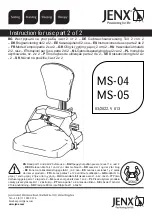
Proper positioning is essential for the occupant safety. When reaching, leaning, bending or bending forward, it is important to use
the casters as a tool to maintain stability and balance.
4.2 Reaching, Bending - Backward
Position wheelchair as close as possible to the desired object. Position the casters so that they are extended away from the rear
wheels to create the longest possible wheelbase. Reach back only as far as the occupant’s arm will extend without changing his/her
sitting position.
WARNING:
DO NOT lean over the top of the back upholstery. This will change the occupant center of gravity and may cause
the occupant to tip over resulting in injury.
4.3 Tipping
1. When tipping the wheelchair, the attendant should hold the back of the wheelchair on a non-removable
(non-detachable) part. Inform the wheelchair occupant before tipping the wheelchair and remind him/her to lean back.
2. Be sure the occupant’s feet and hands are clear of all wheels and/or pinch points.
3. After mastering the techniques of tipping the wheelchair, use this method to tackle curbs, short stairs, etc.
4.4 Stairways
WARNING:
If you fail to heed these warnings, a fall, tip-over, or loss of control may occur and could result in serious bodily
injury to the occupant or others, damage to the chair and surrounding property.
• Occupant should ALWAYS wear the seat/chest positioning belt. If signs of wear appear, belt MUST be replaced
IMMEDIATELY.
• DO NOT attempt to lift the wheelchair by any removable (detachable/foldable) parts. Lifting by means of any
removable (detachable/foldable) parts of a wheelchair may result in serious injury to the occupant or others, or
cause damage to the wheelchair.
• It is recommended the occupant should be removed from the wheelchair prior to moving up or down stairs.
Extreme caution is advised when it is necessary to move an occupied wheelchair up or down the stairs. Use at least
two attendants to move the wheelchair and occupant up or down stairs.
Follow these instructions for moving the wheelchair between floors when an elevator is NOT available:
1. After the wheelchair has been tilted back to the balance point, one attendant (in the rear) backs the wheelchair up
against the first step, while securely grasping a non-removable (non-detachable) part of the wheelchair for leverage.
2. The second attendant, with a firm hold on a non-detachable part of the framework, lifts the wheelchair up and over the
stair and steadies the wheelchair as the first attendant places one foot on the next stair and repeat STEP 2.
3. The wheelchair should not be lowered until the last stair has been negotiated and the wheelchair has been rolled away
from the stairway.
WARNING:
Escalator Usage – DO NOT use an escalator to move a wheelchair between floors. Serious bodily injury may
occur.
4. SAFETY AND HANDLING






































